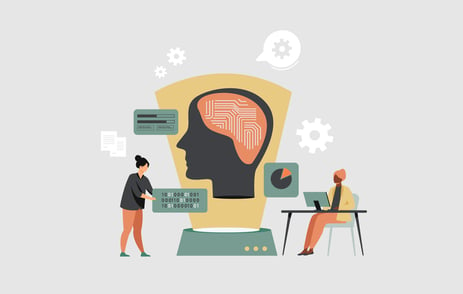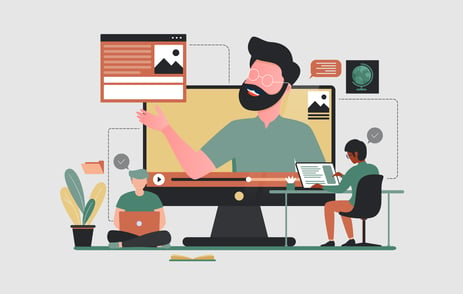For association event planners, ensuring your conference is an engaging experience for attendees is always top of mind. And while you can have the best event platform, pre-planned questions and vibrant speakers and facilitators, it can still be difficult to create an environment that works for everyone.
Although some of your attendees are excited to ask questions and lead discussions, plenty of folks feel specific needs in considering an environment safe to do so. So what can we do to change the way we collaborate and engage at events so everyone feels truly engaged?
At digitalNow 2022, we experimented with a new type of collaboration – liberating structures – and caught up with our facilitator Bridget Mullins to explore what it could mean for the association event landscape.
The Challenges of Traditional Event Engagement
With a background in peacebuilding and conflict transformation, Mullins has focused much of her attention on exploring the ways we gather. One of the consistent trends she’s found is that many of the traditional methods we use for collaboration are unhelpful.
“Some of the common ones we see are that sort of managed discussion or presentation, or on the flip side, an open brainstorm. Oftentimes, it's either over-controlled, so people can't actually participate, or it's under-controlled, leading towards that open free-for-all,” Mullins says. “What happens is that the one or two or three people who feel most comfortable talking and chiming in often end up dominating most of the conversation.”
This lack of interaction can leave your attendees feeling out of place. Similarly, your attendees may group up with people they know, eliminating the impromptu networking you want to see happen at your events. More importantly, without any diversity in opinions or experiences in these conversations, it can also hamper the impact of the content for your attendees.
What Are Liberating Structures?
Developed by Keith McCandless and Henri Lipmanowicz, liberating structures “are easy-to-learn microstructures that enhance relational coordination and trust. They quickly foster lively participation in groups of any size, making it possible to truly include and unleash everyone.”
Through a series of exercises and formats, you can involve just about everyone in the collaboration. Some of the characteristics of liberating structure exercises that make that happen include:
Making Room for Contemplation
When asking attendees to participate, a common concern is they may have nothing to add to the conversation. “A lot of the methods that we normally use are really good for people who are able to just speak off the cuff and speak right away,” says Mullins. “But many people, in order to process or do their best processing, need some time to themself first to even identify, what are my ideas about this?” Many liberating structure exercises often begin with writing. It’s an opportunity to not only allow people to reflect on their own experiences but also to accommodate their learning styles.
“Being attentive to opportunities for visual learners, opportunities for speaking, opportunities for writing, opportunities just for listening — you're trying to tap into different ways that people might feel comfortable,” says Mullins. “It's amazing if you just give them one minute to first write their thoughts to a prompt down, it's going to make them so much more comfortable or able to share with a person when they're eventually put into a group.”
Adding Time Constraints
While there can be complaints that time for collaboration and conversations at events is too limited, the reality is the existing constraints are inefficient. “What often happens in groups is we don't know how much time we're taking for something, and so it just goes on and on until we decide we're done,” says Mullins. “At digitalNow, the first method we used was impromptu networking. That involves people chatting in pairs for about two minutes, then finding another person.”
Not only are you able to help facilitate quick and efficient discussions, but as Mullins explains, you’re also allowing your attendees to hear different perspectives on the same prompts outside of their organization and in a more intimate setting conducive to engagement.
Leveraging Collaboration and Experiences
Your attendees come to the conference or annual meeting to learn new things they can bring back to their own organizations. And while your speakers can help provide those lessons, you also need to find ways to leverage your audience.
“An underlying principle of liberating structures is that these people are wise, these people have experience. It puts the role of the expert into the hands of all the people who are participating,” says Mullins. “It's this idea that, what if the solutions we needed actually already existed among us? We just need to have different processes that are going to bring those out. A lot of methods rely on that shared generating of solutions and tapping into more of the wisdom of each person there.”
3 Liberating Structure Exercises to Experiment With
One of the fun parts of liberating structures is there are many different exercises (over 30 total) that you can experiment with in your event or organization. Some that Mullins recommends trying include:
- Impromptu Networking – This method is a great way to start a meeting or conference by allowing attendees to connect immediately with a guided prompt. “We might even just use a prompt like, what's one thing you're hoping to get from this experience, and what's one thing you're hoping to give?” says Mullins.
- 1-2-4-All – This method is excellent for honing in on the energy of a group. “It can be really fun if you're at an event and moving to the Q&A session to source those questions from the audience. “We're going to have you write down what you think you want to hear for one minute, then get with a pair and see what questions you have, then get with a group of four and see, is there any question that would tie your questions together? So it's great relying on people to find what's most important across us as a group,” says Mullins.
- Troika Consulting – It's a method where people become consultants for each other. They bring a problem that they have, and there's a structured way of them sharing about the problem. The other two people ask them questions about it. And then the two “consultants” have conversations. “This is really powerful when you're bringing people together that have some kind of connection – like they're in the same field or area of work together – but they're not necessarily on the same team where they're too entrenched in each other stuff. That's a really cool way to get practical help from colleagues that are converging at a gathering.”
Changing the Way We Think About Event Collaboration
The biggest challenge with using liberating structures, or any new engagement practice at an association conference, is often buy-in. “We actually need to disrupt a lot of that mindset to get to new possibilities and new ideas and solutions for the stuff that associations are facing,” says Mullins.
“In order to get to innovative solutions, we can't use the same methods that you've been using because that's going to generate the same thoughts that have been generated. So what innovation sometimes looks like is people doing stuff that's outside of their comfort zone or tapping into their brain literally, in different ways.”
So whether that means workshopping your association’s challenges with complete strangers or creating more meaningful connections with fellow attendees, there’s a lot that can be done to elevate an event experience.

November 11, 2022


